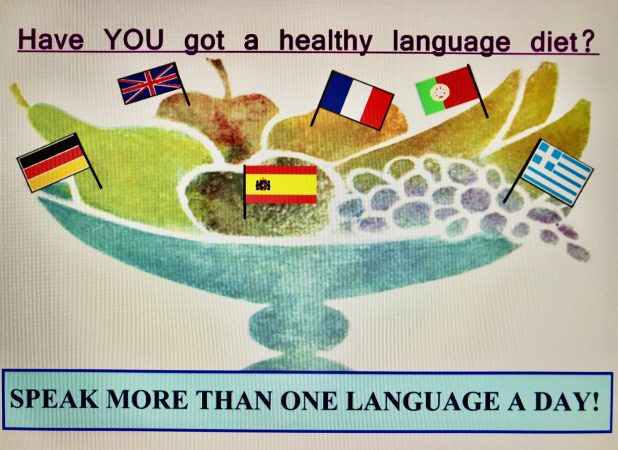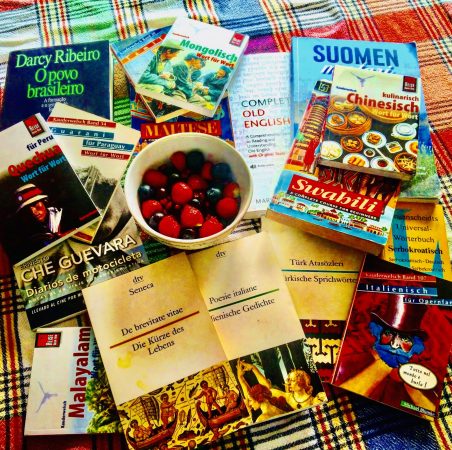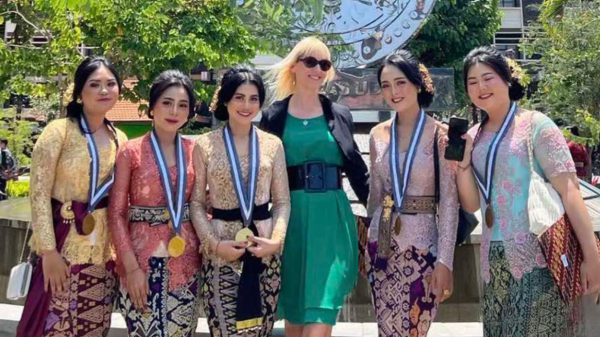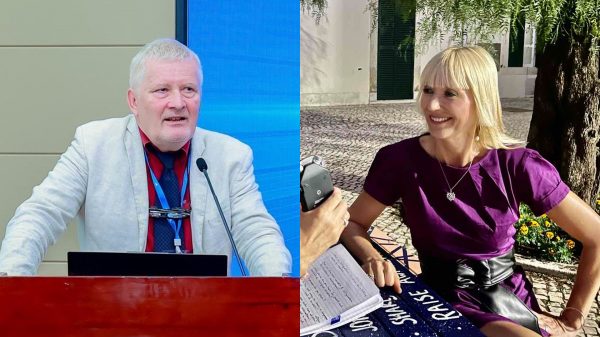
25.09.20
European Day of Languages, 26.9.2020
By Dina Mehmedbegovic-Smith and Thomas H Bak
Four years ago, Dina and Thomas have met for the first time, at a celebration of the European Day of Languages at the European Commission in Brussels and we are grateful to our colleagues at EU Commission for facilitating our initial meeting. We discovered immediately that despite coming from very different professional backgrounds (education practice in children vs. cognitive ageing and dementia) we had a lot in common: not last, the idea of a “healthy linguistic diet”, for all ages, for wellbeing of individuals and societies.
Today, we celebrate the European Day of Languages and four years of our partnership with these two blogs explaining how we have developed our ideas and our vision for the future. We explain our aim to bring together education and health research, practice and policy to work in partnership and in an interdisciplinary way.
To all our readers and colleagues we wish a happy and inspirational European Day of Languages.
Thomas & Dina
Evropski dan jezika, 26.9.2020.
Na ovaj dan prije cetiri godine, Dina and Thomas su se sreli po prvi put, na predavanju povodom proslave Evropskog dana jezika u organizaciji Evropske komisije u Briselu – nasa velika zahvalnost kolegama iz Evropske Komisije koji su organizirali nase upoznavanje. Odmah smo otkrili da bez obzira sto dolazimo iz vrlo razlicitih profesija (obrazovanje djece versus kognitivno starenje i dimencija) da imamo puno toga zajednickog, a najvaznije: ideju ‘zdrave jezicke ishrane’, za sva zivotna doba, za dobrobit pojedinca i drustva.
Danas obiljezavamo Evropski dan jezika i cetiri godine nase saradnje sa ova dva bloga koji objasnjavaju kako su se nase ideje razvijale i koja je nasa vizija za buducnost. Nas cilj je da spojimo obrazovanje i zdravstvo kroz istrazivanja, praksu i strategiju, kako bi se ostvarila saradnja kroz interdisciplinarni pristup.
Svim nasim citateljima i kolegama zelimo sretan and inspirativan Evropski dan jezika.
Dina & Thomas

A poster by a pupil
One day I had to take a bus – Dina Mehmedbegovic-Smith
On this occasion I would like to share with our readers a moment I witnessed on a bus last year and how it inspired my Healthy Linguistic Diet vision. I don’t often take buses because I am a passionate and committed cyclist, but I was out of London and had to take a bus. I’m glad I did. I had the opportunity to observe two 14-year-old boys discussing what they were going to have for lunch. They talked about different food choices and their composition in terms of: proteins, fats, carbs and sugars. They were not only looking to make good choices, they were passionate about the importance of proteins and healthy fats. Their demonstrated very impressive knowledge and even more impressive drive to make the best food choices. This high level of healthy diet awareness amongst young people implemented in independent everyday food choices is a direct result of concentrated and strategic government efforts to shape healthy eating habits through education and health institutions and media. My immediate thinking was: the same is needed in order for the individuals and society to benefit from cognitive benefits of Healthy Linguistic Diet: health and education departments, practitioners and researchers need to work in partnership to mirror the success achieved in raising awareness on physical health. Our vision is that in not so distant future we will be witnessing ‘Healthy Linguistic Diet conversations’ in public and private spaces amongst children and adults passionate about using two or more languages for their cognitive well-being.
One common concern teachers have in multilingual learning communities is often articulated as: How do I as a teacher, who does not speak any of the languages spoken by my students, support each one of my students to use his/her home languages and further develop their plurilingualism?
This concern is a big hurdle in utilising home languages in the development of plurilingual competences. HLD has been designed to help educators find ways to utilise the plurilingual capital of every child in their classroom regardless of differences in their linguistic backgrounds. It is understandable that engaging with hyperdiversity in global cities can feel overwhelming for educators looking to provide support to learners using such a wide range of languages. I discuss complexities and language hierarchies in global cities in this article: http://healthylinguisticdiet.com/wp-content/uploads/2018/11/Engaging_with_Linguistic_Diversity_in_Global_Citie.pdf . Lack of available training and professional development makes it very hard to develop practices which are necessary for the development of plurilingual competencies. Providing a language learning framework that taps into existing, well established understandings means a positive reception, as we have so far encountered in our dissemination work detailed on our website. The fact that HLD is based on a direct analogy between optimal physical and cognitive functioning makes it instantly acceptable. Regular physical activity and a healthy diet are regarded widely as the two most important factors in developing and maintaining physical health and increasingly as a way to prevent illnesses such as diabetes. In the same way that walking, running, swimming, cycling and other types of exercise are essential for our metabolism, cardiovascular health, healthy muscles and bones; challenging mental activity is essential to keep our brains and cognitive functioning at their optimal levels, and they too have preventative aspects.
Our mission is to make the research evidence we have relevant to language learning and cognitive functioning accessible, available and utilised. We intend to equip all stakeholders with knowledge to discuss with enthusiasm learning and using other languages as a cross generational ingredient for healthy lifestyles. Our research and publications are available on this link: http://healthylinguisticdiet.com/publications/
 Blueberries & Languages – Thomas H Bak
Blueberries & Languages – Thomas H Bak
Many years ago, doing my monthly Huntington’s Disease Specialist Clinic at the Addenbrooke’s Hospital in Cambridge, I had a day where almost all patients and their families coming into the consultation room asked me whether eating blueberries can cure their disease. I was rather surprised until one of my colleagues explained that a blueberry-producing farm, somewhere in the West Country I think, managed to get to the top of the internet hits when people were asking about treatment for Huntington’s Disease. The argument was that blueberries, containing anti-oxidants, can counteract the effects of neurodegenerative diseases such as Huntington’s. Not too expensive and easily available, blueberries make certainly a good choice of food, but the idea that they might cure a disease that had defied all attempts at treatment didn’t seem to be very realistic.
The story made me reflect on two things: one is the ease with which internet information can be manipulated, the other the way in which we think about diet. The very idea of a diet is that it does not consist of one ingredient: it is the combination of different products which can produce health-relevant effects. Mediterranean diet is not just about olives (as important as they are, including the olive oil), Japanese diet not just about sushi.
This metaphor of the diet as a combination of different ingredients came into my mind again many years later, when I was working on factors which could increase our resilience against cognitive ageing and diseases such as dementia (the so-called “cognitive reserve”). One of the best documented factors, apart from the diet, is physical activity. Mental activity (and this includes learning and using different languages) is more difficult to quantify, but growing evidence suggests that it can also play an important role. And like in diet, what matters is not a single body movement or a single mental task repeated ad infinitum, but their variety and their combination.
Accordingly, when asked in my press, radio and TV interviews about the effects of language learning and use (as well as other mental activities, from games to music) I was often using the metaphors of diet and of physical exercise.
Exactly 4 years ago, at a European Commission event in Brussels celebrating the European Day of Languages, I met Dina Mehmedbegovic and I was stunned how we seem to have arrived at the same metaphor of diet, coming from two very different backgrounds: school education in her case, cognitive neurology in mine. We decided to put our efforts together and in the following years we have written a paper on the “Healthy Cognitive Diet”: http://www.meits.org/policy-papers/paper/healthy-linguistic-diet and established a website with the same name: http://healthylinguisticdiet.com/.
The core of our idea is that linguistic variety benefits individuals as well as societies. The positive effects of languages are not confined to idealised “perfect” bi-/multilinguals, with “native-like” proficiency in all their languages. Even a one-week intensive course in Gaelic led to a measurable improvement in attention: https://journals.plos.org/plosone/article?id=10.1371/journal.pone.0153485. Indeed, a recent study suggested that just an exposure to different languages can influence the way in which the brain reacts to sounds of a new language: https://www.sciencedirect.com/science/article/abs/pii/S0093934X18303274.
Although we use the terms “bilingual” and “multilingual” in our studies, we find that our idea of “living in different languages” is best expressed by the term “plurilingual”: http://healthylinguisticdiet.com/bilingualism-multilingualism-and-plurilingualism-living-in-two-or-more-languages/. The concept of plurilingualism includes, apart from languages in which we are proficient and feel comfortable to express our thoughts and feelings all other languages which contribute to our lives: those in which we can read but not speak, speak but not read, in which we can follow the gist of a conversation or understand the news and those which we are just learning; even those which simply sound familiar, like a voice of a friend or a distant relative. We believe that such a healthy balance of what we know, what we can guess and what we still want to learn can contribute to healthier lives and healthier societies; like a versatile healthy diet. Blueberries are great, but a fruit bowl containing all kinds of fruit, including blueberries, is even better.


